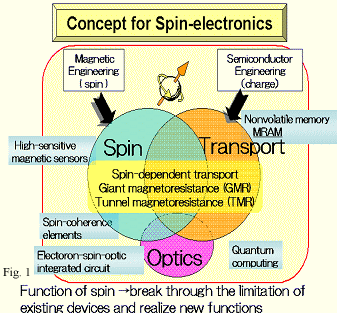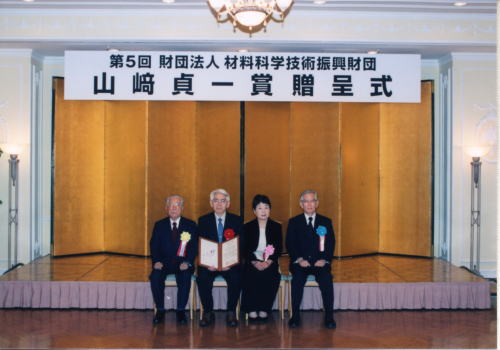The 5th (2005) Yamazaki-Teiichi Prize Winner Material
Study on the Application of Tunnel Magnetoresistance Junctions
| Winner | ||
|---|---|---|
| Terunobu Miyazaki | ||
| Affiliation at the time of the award | ||
| Professor,Department of Applied Physics, Faculty of Engineering, Tohoku University |
Reason for award
To boost the recording density of the hard disk drive (HDD), which is the storage medium for computers, in addition to its recording performance to magnetic discs, improvement of their reading performance is extremely effective. Making high-performance magnetic heads for this purpose can thus be compared to the history by which high recording density was developed for HDDs.
A review of this history to the present reveals that first, magnetic heads utilizing AMR effect emerged for achieving high recording density, followed by magnetic heads utilizing GMR effect. However, improvement of recording density knows no stopping. Eventually, people came to expect recording density exceeding 100Gbit/inch2, which was difficult to achieve with magnetic heads utilizing GMR effect.
The development of magnetic heads utilizing the TMR effect has been active in recent years, as they are considered to be superior to heads that utilize the GMR effect. Thus, the possibility has arisen that all GMR heads will be replaced with TMR heads. The TMR effect is a magnetoresistive effect that occurs in a tunnel junction in which a thin insulator is held between ferromagnets. The first report on the TMR effect, at a low temperature (4.2K) was made in 1975 by Julliere of University of Rennes, France. Although there have been numerous reports since then, they have not received much attention, owing to their low MR ratio at room temperature: under 1%.
Terunobu Miyazaki has been researching MR effect since around 1985. Inspired by a report on GMR involving an artificial metal lattice in 1988, he undertook research on the TMR effect, which involves the same spin-dependent conductivity. In 1991, Miyazaki discovered TMR effect of 2.7% at room temperature, which led to his discovery of a giant TMR effect with an MR ratio of 18% with a Fe/Al2O3/Fe junction in 1994.
Since then, he has led Japan's development of TMR magnetic heads. During this time, he has also focused on developing important technology geared to practical application, such as by optimizing electrode and insulation materials, making tunnel resistance low and stabilizing the TMR effect. His research papers have been cited 281 times throughout the world, and from the fact that his announcements have led to sudden increases in patent applications pertaining to TMR, as well, the major impact that his TMR-related research has had on the world is palpable. At present, the US company Seagate Technology, Inc. has announced its full-scale adoption of a 2.5-inch HDD using TMR heads, and TDK has announced that in 2006, it will be incorporating TMR in perpendicular magnetic recording for mass production.
Hitachi and Fujitsu have also reported their adoption of TMR heads. Even with the various contrivances each company has made for practical application, Miyazaki's achievement in constructing the basis for them is immense. In addition, TMR technology will be the source for the development of MRAM, of which much is expected as a memory element for the future.
The foundation for TMR that Miyazaki has established will not only vastly sustain the HDD market, which has been valued at ¥3 trillion, but also constitutes a major contribution to the establishment and expansion of spin electronics as important technology for activating new R&D henceforth in relevant fields. In keeping, he has been awarded the Material Prize.
Background of research and development
Tunnel magnetoresistive (TMR) effect is a magnetoresistive (MR) effect that occurs in a tunnel junction in which a thin insulator is held between ferromagnets (with a ferromagnetic layer on both sides of the insulating layer). Similar to other MR effects, such as anisotropic magnetoresistive (AMR) effect and giant magnetoresistive (GMR) effect, its conductivity is spin-dependent. The first report on the TMR effect was made by Julliere in 1975. Thereafter, several groups reported on it, but because of the small rate of change (less than 1%) in MR at room temperature, the reports did not receive significant attention.
Achievements
In 1991, the prizewinners discovered TMR effect of 2.7% at room temperature; in 1994, they discovered a giant TMR effect of 18% at room temperature with a Fe/Al2O3/Fe junction. Since then, the prizewinners have led the development in Japan of magnetic playback heads and solid-state magnetic memory using TMR elements. The specific issues they encountered included (1) optimizing junction electrode materials, (2) making junction tunnel resistance low and (3) improving TMR effect and thermal stability through thermal treatment.
The technology for these and related achievements included (i) technology to manufacture and evaluate uniform and thin insulating layers and (ii) planarizing technology for interfaces between magnets and insulators and technology to evaluate interface condition. For the former, an ICP plasma oxidation method and Conducting Atomic Force Microscope were adopted for manufacturing thin insulating layers (low-resistance tunnel junctions); for the latter, Inelastic Electron Tunneling Spectroscopy was adopted for interface evaluation, enabling successful manufacture of quality tunnel junctions. As a result, high TMR ratios of 50% at room temperature and 77% at 4.2 K could be obtained:.
Recently, tunnel junctions with MgO barriers and tunnel junctions that use Heusler alloys for electrodes have been the subject of attention; the prizewinners are world-leading researchers on tunnel junctions using Heusler alloys.
Meaning of the achievements
The first achievement of this research to be cited is its contribution to the development and practical application of high-density HDDs in the 100 Gbit/inch2 class, along with its contribution to the development of MRAM, a nonvolatile memory. Although MRAM has yet to reach the practical application stage, samples are being shipped and R&D is being conducted around the world, with expectations increasing daily. In addition to contributing to these industry developments, this research also has major academic significance, as it contributes to the establishment of the discipline of spin electronics (see figure below). Henceforth, through rapid development of the spin electronics field, zero-standby-power computers with energy-saving memory that will not be lost even in the event of fires or disasters will become possible, thus contributing to the actualization of an environment-friendly society.

Fig. 1. Concept of spin electronics.
The establishment of the field of spin electronics was triggered by the discovery of giant GMR and giant TMR effects, with their spin-dependent conductivity. For now, HDDs, MRAM and ultra-sensitive sensors are the industry's targets; other themes for future R&D are also indicated.

